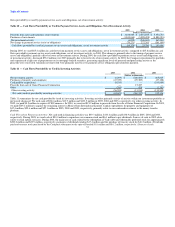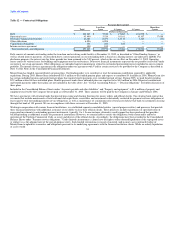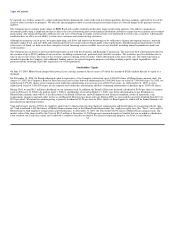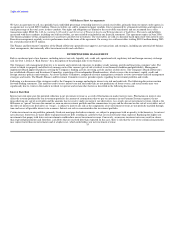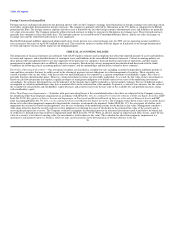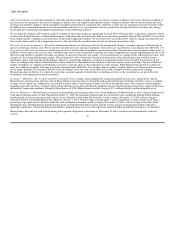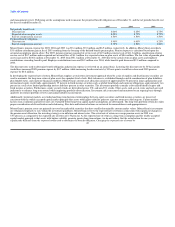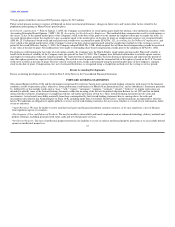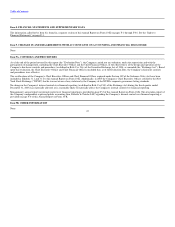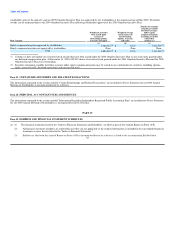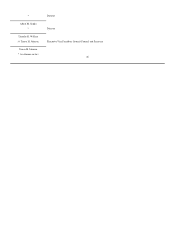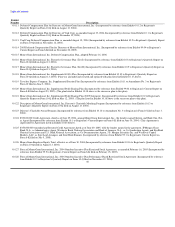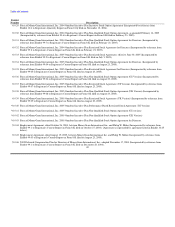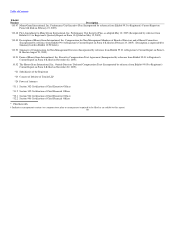MoneyGram 2005 Annual Report Download - page 44
Download and view the complete annual report
Please find page 44 of the 2005 MoneyGram annual report below. You can navigate through the pages in the report by either clicking on the pages listed below, or by using the keyword search tool below to find specific information within the annual report.
Table of Contents
50 basis points would have increased 2005 pension expense by $0.5 million.
Future actual pension income or expense will depend on future investment performance, changes in future rates and various other factors related to the
populations participating in MoneyGram's pension plans.
Stock-based compensation — Prior to January 1, 2005, the Company accounted for its stock option grants under the intrinsic value method in accordance with
Accounting Principles Board Opinion ("APB") No. 25, Accounting for Stock Issued to Employees. This method defines compensation cost for stock options as
the excess, if any, of the quoted market price of the Company's stock at the date of the grant over the amount the employee must pay to acquire the stock. As
our stock option plans require the employee to pay an amount equal to the market price on the date of grant, no compensation expense was recognized under
APB No. 25. Performance-based stock and restricted stock awards were accounted for under SFAS No. 123, Accounting for Stock-Based Compensation, and
were valued at the quoted market price of the Company's stock at the date of grant and expensed using the straight-line method over the vesting or service
period of the award. Effective January 1, 2005, the Company adopted SFAS No. 123R, which requires that all share-based compensation awards be measured
at fair value at the date of grant. No modifications were made to outstanding share-based compensation awards prior to the adoption of SFAS No. 123R.
For purposes of determining the fair value of stock option awards, the Company uses the Black-Scholes single option pricing model. Expected volatility is
based on the historical volatility of the Company since the spin-off on June 30, 2004. The Company uses historical information to estimate option exercise
and employee termination within the valuation model. The expected term of options granted is based on historical information and represents the period of
time that options granted are expected to be outstanding. The risk-free rate for periods within the contractual life of the option is based on the U.S. Treasury
yield curve in effect at the time of grant. The fair value of restricted stock awards is determined using the quoted market price of the Company's common
stock on the date of grant. Compensation cost, net of estimated forfeitures, is recognized using a straight-line method over the vesting or service period.
Recent Accounting Developments
Recent accounting developments are set forth in Note 2 of the Notes to the Consolidated Financial Statements.
FORWARD LOOKING STATEMENTS
This Annual Report on Form 10-K and the documents incorporated by reference herein may contain forward-looking statements with respect to the financial
condition, results of operations, plans, objectives, future performance and business of MoneyGram International, Inc. and its subsidiaries. Statements preceded
by, followed by or that include words such as "may," "will," "expect," "anticipate," "continue," "estimate," "project," "believes" or similar expressions are
intended to identify some of the forward-looking statements within the meaning of the Private Securities Litigation Reform Act of 1995 and are included,
along with this statement, for purposes of complying with the safe harbor provisions of that Act. These forward-looking statements involve risks and
uncertainties. Actual results may differ materially from those contemplated by the forward-looking statements due to, among others, the risks and
uncertainties described in this Annual Report on Form 10-K, including under Item 1A entitled "Risk Factors," and the documents incorporated by reference
herein. We undertake no obligation to update publicly or revise any forward-looking statements for any reason, whether as a result of new information, future
events or otherwise.
• Agent Retention. We may be unable to renew material retail agent and financial institution customer contracts, or we may experience a loss of business
from significant agents or customers.
• Development of New and Enhanced Products. We may be unable to successfully and timely implement new or enhanced technology, delivery methods and
product offerings, including pre-paid stored value cards and new bill payment services.
• Intellectual Property. The loss of intellectual property protection, the inability to secure or enforce intellectual property protection or to successfully defend
against an intellectual property in- 41


